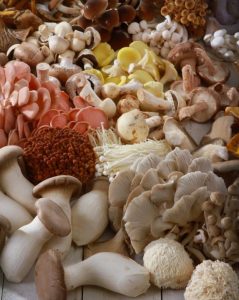Mothers who garden probably have the best Mother’s Days… but I think moms who don’t garden still deserve to celebrate with the same joy, beauty, and nourishment that comes from using fresh spring veggies.
Whether you’re planning a brunch, dinner, or just a quiet moment in the sun, we’ll show you in this post how to create a celebration that feels special, seasonal, and deeply nourishing.
You don’t need a backyard garden to enjoy vibrant, just-picked produce. At Willow Haven Farm, we grow organic, nutrient-dense vegetables so families like yours can eat well, live well, and stay connected to their food—even if you never touch a trowel.
In today’s video, you’ll join me and two of our farm kids in the field as we transplant bok choy and endive into the spring soil.
You’ll get a behind-the-scenes peek at how your food is grown with care, sunshine, and a little help from homeschool hands.
Because the best meals start with real food—and real connection.
FEATURED: More Meal Ideas Using Fresh Spring Veggies
As spring vegetables come into their prime, they offer vibrant colors and fresh flavors perfect for celebrating Mother’s Day or any spring occasion. From tender greens to sweet roots, these early-season veggies brighten up any dish. Here are some creative recipe suggestions and pairing ideas to inspire a wholesome and flavorful celebration all season long.
MEAL IDEAS FOR YOUR LOCAL ORGANIC FOOD THIS WEEK:
Many of these recipes include produce or other items you may have received in your market box. You may also see ingredients you can purchase at the WHF General Store. Experiment and see what you can use to create your meal plan!
💡Pro tip: Always check your recipes to see what you have and what you need to purchase. Takes a few extra minutes in planning, but it beats finding out at the last minute that you’re missing ingredients!
Asparagus (spring spears—tender, grassy, and quick to cook)
- Quick Recipe:
- Pan-Seared Asparagus – Trim ends, sear spears in a hot skillet with olive oil or butter until just tender and slightly charred, 5–7 min. Finish with lemon zest or grated cheese.
- Easy Uses & Pairings:
- Add to frittatas, quiches, or scrambled eggs.
- Toss into pasta, grain bowls, or risotto with lemon and herbs.
- Serve alongside salmon, chicken, or pork for a spring-forward meal.
- Shave raw into salads or slaws with citrus or vinaigrette.
- 💡Tip: Tough ends can be simmered in broth or puréed into soup for zero waste.
- 💡Tip: You can also pickle the tough ends! Slice into smaller pieces and pickle in a simple brine of vinegar, sugar, salt, and water. They’ll make a tangy, crunchy snack or a unique salad addition.
Baby Red Beets (tender, earthy, and slightly sweet — great roasted, raw, or pickled)
- Quick Recipe:
- Baby Beet & Greens Soup – Sauté chopped onion and garlic in olive oil. Add chopped beet greens (stems too!) and cook a few minutes. Pour in broth, add cooked grains (like farro) and white beans. Simmer, season, and finish with roasted baby beet halves for sweetness and color. A splash of lemon or vinegar brightens it all up.
- Easy Uses & Pairings:
- Slice raw baby beets thinly for a colorful, earthy addition to mixed greens. Pair with goat cheese, arugula, and a citrus vinaigrette.
- Toss roasted baby beets with whole grain pasta, fresh herbs, and olive oil.
- Serve roasted or pickled baby beets with farro, quinoa, or rice and pair with roasted chicken, lamb, or grilled fish.
- Roast baby beets as a side dish to accompany meats like pork, steak, chicken, or turkey.
Dandelion Greens (bitter, bold greens — great raw or cooked)
- Quick Recipe:
- Sautéed Dandelion Greens – Blanch greens 1 min, then sauté in olive oil with garlic and chili flakes. Finish with a splash of vinegar or lemon juice.
- Easy Uses & Pairings:
- Use raw in salads with bacon, apples, or goat cheese.
- Add to hearty dishes like pasta, beans, soups, or stews to balance richness.
- Pairs well with eggs, fatty meats (like sausage or pancetta), or sharp cheese.
- Blend into pesto with nuts, garlic, olive oil, and lemon for a bold twist.
Garlic Chives (flat leaves, grassy and garlicky, milder than bulb garlic)
- Quick Recipe:
- Garlic Chive Oil – Blend 1 cup chopped garlic chives with ½ cup neutral oil (or olive oil), a pinch of salt, and a squeeze of lemon. Use immediately or store in the fridge for a few days.
- 💡Tip: Add a few mint or basil leaves for a herby variation.
- Easy Uses & Pairings:
- Drizzle on eggs, grain bowls, noodles, or roasted veggies.
- Mix into softened butter or cream cheese for toast.
- Pairs well with seafood, tofu, rice, and spring rolls.
- Chop garlic chives into small pieces and sprinkle them over scrambled eggs, avocado toast, or a bowl of soup for a burst of mild garlic flavor without the sharpness of raw garlic.
Green Garlic (young garlic before it bulbs, tender and mild)
- Quick Recipe:
- Green Garlic Sauté – Thinly slice green garlic (white and light green parts). Sauté in butter or olive oil until soft. Use as a base for scrambled eggs, pasta, or pan sauce.
- Easy Uses & Pairings:
- Stir into risotto, mashed potatoes, or savory tarts.
- Add to soups or use in pesto for a garlicky spring twist.
- Pairs well with asparagus, mushrooms, chicken, or white beans.
- Use green garlic as a substitute for onions in savory dishes for a unique twist. Its milder flavor works well when blended into mashed potatoes or added to vegetable stir-fries.
Rhubarb (tart stalks — best cooked or sweetened to shine)
- Quick Recipe:
- Simple Roasted Rhubarb – Cut rhubarb into chunks, toss with honey or sugar and a splash of orange juice, then roast at 375°F for 15–20 min. until tender. Serve over yogurt, oatmeal, or ice cream.
- Easy Uses & Pairings:
- Make compote, jam, or sauce to top pancakes, toast, or pork.
- Bake into crisps, muffins, or quick breads with strawberries or ginger.
- Add diced rhubarb to chutneys or BBQ sauces for a savory contrast.
- Use sweetened rhubarb syrup in cocktails or homemade soda.
- 💡Important Tip: Leaves are toxic—discard or compost only.
Stinging Nettle (tamed by cooking — earthy, spinach-like flavor)
- Quick Recipe:
- Nettle Pesto – Blanch 2 cups nettle leaves (30 sec), squeeze dry. Blend with garlic, nuts/seeds, olive oil, lemon, and salt. Spread on toast, stir into pasta, or swirl into soup.
- Easy Uses & Pairings:
- Add blanched nettles to omelets, polenta, or pizza.
- Mix into gnocchi or savory pancakes.
- Excellent with earthy mushrooms, goat cheese, eggs, or grilled sausages.
- 💡Important Tip: Always blanch nettles briefly to remove the sting before using in any dish.
FEATURED: Local, Organic Almond Butter and Peanut Butter
Local organic nut butters add rich, creamy texture and natural flavor to both sweet and savory dishes. They’re perfect for adding depth to sauces, baked goods, and snacks, all while offering a healthy dose of protein and healthy fats. Natural almond butter contains more Vitamin E, while peanut butter often has more protein per serving. Both are powerhouse pantry staples that can help keep meals satisfying. Need some new ways to use that jar of local nut butter? We’ve got you covered with easy, delicious ideas that go way beyond toast. Check out our guide for Creative Ways to Use Local Almond and Peanut Butter. You’ll never look at nut butter the same again!
BEVERAGES:
- Visit our beverages page to find ingredients to create special cocktails and mocktails for your spring celebrations.
- Refreshing herbal sodas and sparkling waters
- Juices and shrubs
- Kombucha
- Of course, we have coffee and tea for your spring brunch (and every day) sipping pleasure!
- Visit our Mother’s Day page for new tea selections!
MEAT AND SEAFOOD:
- Salmon and shrimp are lovely spring brunch proteins. Check out our offerings from Wild for Salmon.
- Sausage, bacon, scrapple, and ham are also great brunch items.
- Boneless, skinless chicken breast is a perfect addition to grain and noodle bowls or fresh, spring salads.
DAIRY:
- Goat cheese pairs well with baby red beets and leafy greens. Explore our selection of goat cheeses (yummy flavors!) and add some to your market box order.
- You may find a quick milkshake recipe in our nut butter guide this week. Make sure you have plenty of raw milk on hand!
- Fresh, pastured eggs are a must for your spring brunch menus. Stock up this week!
PANTRY RECOMMENDATIONS:
- Several meal ideas this week call for items like noodles, farro, quinoa, or beans. Be sure to stock up on what you need.
- If you’re baking something sweet for Mother’s Day, now is the time to check your recipes and gather your ingredients. We can help with all your baking needs – flours, sweeteners, baking soda/baking powder, nuts, dried fruit, and more.
🫖🍯🌱🌺Visit our Mother’s Day page for special brunch and tea bundles and great gift ideas.
🎁💐Stop in and visit us at WHF General Store for your Mother’s Day meal needs. We also have cards, flowers, treats, and unique locally-made gifts!
FRUIT:
Storage for all apple varieties: Keep unwashed apples in a plastic bag in the refrigerator’s crisper drawer, where they can stay fresh for up to two weeks.
 Apple, Crimson Topaz – Crimson Topaz is a striking red apple with a tangy-sweet flavor, originally bred in the Czech Republic and now grown in small quantities elsewhere. It’s an organic grower’s favorite thanks to its natural disease resistance. Nutritionally, it’s similar to other apples – low in calories, high in fiber, and rich in vitamin C and antioxidants from its deep red skin. Crimson Topaz apples are great for fresh eating if you like a sharper bite, and they add depth to salads and cheese boards. They also bake beautifully, adding tartness to pastries and tarts.
Apple, Crimson Topaz – Crimson Topaz is a striking red apple with a tangy-sweet flavor, originally bred in the Czech Republic and now grown in small quantities elsewhere. It’s an organic grower’s favorite thanks to its natural disease resistance. Nutritionally, it’s similar to other apples – low in calories, high in fiber, and rich in vitamin C and antioxidants from its deep red skin. Crimson Topaz apples are great for fresh eating if you like a sharper bite, and they add depth to salads and cheese boards. They also bake beautifully, adding tartness to pastries and tarts.
 Apple, EverCrisp – EverCrisp apples are a hybrid of Honeycrisp and Fuji, combining the crisp texture of the former with the sweetness and dense flesh of the latter. Developed for late-season storage, they retain their crunch and flavor for months when kept cold. Nutritionally, EverCrisp apples offer about 80–100 calories per medium apple, with around 4 grams of fiber and a good dose of vitamin C. They’re excellent for snacking due to their satisfying crunch and balanced sweetness, but also hold up well in pies, crisps, and slaws.
Apple, EverCrisp – EverCrisp apples are a hybrid of Honeycrisp and Fuji, combining the crisp texture of the former with the sweetness and dense flesh of the latter. Developed for late-season storage, they retain their crunch and flavor for months when kept cold. Nutritionally, EverCrisp apples offer about 80–100 calories per medium apple, with around 4 grams of fiber and a good dose of vitamin C. They’re excellent for snacking due to their satisfying crunch and balanced sweetness, but also hold up well in pies, crisps, and slaws.
 Apple, Fuji – Fuji apples are sweet, crisp, and juicy, with a dense texture, making them a popular snacking apple. They are rich in dietary fiber, vitamin C, and antioxidants, which support digestion, immune health, and skin vitality. Fuji apples can be eaten fresh, added to salads, baked into desserts, or cooked into sauces.
Apple, Fuji – Fuji apples are sweet, crisp, and juicy, with a dense texture, making them a popular snacking apple. They are rich in dietary fiber, vitamin C, and antioxidants, which support digestion, immune health, and skin vitality. Fuji apples can be eaten fresh, added to salads, baked into desserts, or cooked into sauces.
 Grapefruit – Grapefruit is a citrus fruit known for its juicy, tangy-sweet flavor with a slight bitterness. It is rich in vitamin C, fiber, and antioxidants like lycopene, promoting immune health, heart health, and skin health. Grapefruit can be eaten fresh, added to salads, or juiced for a refreshing drink. Store whole grapefruit at room temperature for up to a week or in the refrigerator for up to three weeks.
Grapefruit – Grapefruit is a citrus fruit known for its juicy, tangy-sweet flavor with a slight bitterness. It is rich in vitamin C, fiber, and antioxidants like lycopene, promoting immune health, heart health, and skin health. Grapefruit can be eaten fresh, added to salads, or juiced for a refreshing drink. Store whole grapefruit at room temperature for up to a week or in the refrigerator for up to three weeks.

Lemon – Lemons are tangy citrus fruits packed with vitamin C, antioxidants, and citric acid, which aid digestion, boost immunity, and enhance skin health. They are commonly used to add flavor to beverages, marinades, dressings, and desserts or as a natural cleaning agent. Store lemons at room temperature if using them soon or refrigerate them in a perforated bag to extend their shelf life up to 3-4 weeks.
 Orange, Navel – Navel oranges are sweet, seedless, and easy to peel, making them an excellent snack or addition to salads and desserts. They are high in vitamin C, fiber, and antioxidants, which promote immune health and support heart health. Store navel oranges at room temperature for up to a week or refrigerate them in a mesh bag for up to three weeks to maintain freshness. Wash before peeling or slicing.
Orange, Navel – Navel oranges are sweet, seedless, and easy to peel, making them an excellent snack or addition to salads and desserts. They are high in vitamin C, fiber, and antioxidants, which promote immune health and support heart health. Store navel oranges at room temperature for up to a week or refrigerate them in a mesh bag for up to three weeks to maintain freshness. Wash before peeling or slicing.
Organic Veggies We Harvested This Week:
To help you use everything in your box this week, use this Meal Planning Guide to keep track of what’s in the fridge, what needs to be used first, and what you have planned or prepped for each day.
Every member’s customized Market Box is unique, so we hope you will take advantage of more varieties of vegetables as you get comfortable with all the great organic produce we are offering.
Tessa’s Tips
What to use first: chives, green onions, green garlic, salad greens, mushrooms
Longest Storage: apples, beets, carrots, potatoes
Pro-tip: Look at the items in your market box right away and decide how you will use them in your meal planning for the week. Freeze any veggies you know you won’t be able to eat in the week.

Arugula – This leafy green has a peppery, slightly bitter flavor and is commonly used in salads, sandwiches, and as a garnish. It is low in calories and packed with vitamins A, C, and K, as well as folate and antioxidants, which support eye health, immune function, and bone strength. Arugula can be eaten fresh or lightly wilted in pasta dishes and pizzas. Some prefer to eat it tossed with other fresh greens or lettuce so that the spicy taste is not as strong. Putting it on a sandwich is another delicious way to enjoy its distinct flavor. Store wrapped in a paper towel inside a loosely sealed plastic bag in the refrigerator crisper drawer. Properly stored, arugula can stay fresh for up to 3-5 days. For best quality, use arugula soon after purchasing.
💡Tip: Arugula isn’t just for salad. Here are 29 Ways to Eat Arugula including pasta dishes, pizza, sandwiches, and more.
 Asparagus – This spring vegetable is prized for its tender, nutrient-packed stalks. Rich in vitamins A, C, E, K, and folate, asparagus is also a good source of fiber and antioxidants. Its mild, earthy flavor makes it versatile in various dishes, from grilling and roasting to adding to pastas and salads. Asparagus is available in green, white, and purple varieties, with the green being the most common. Store fresh asparagus upright in a jar with a little water in the fridge, or wrapped in a damp towel inside a plastic bag, and use within 3–5 days for the best taste and texture.
Asparagus – This spring vegetable is prized for its tender, nutrient-packed stalks. Rich in vitamins A, C, E, K, and folate, asparagus is also a good source of fiber and antioxidants. Its mild, earthy flavor makes it versatile in various dishes, from grilling and roasting to adding to pastas and salads. Asparagus is available in green, white, and purple varieties, with the green being the most common. Store fresh asparagus upright in a jar with a little water in the fridge, or wrapped in a damp towel inside a plastic bag, and use within 3–5 days for the best taste and texture.
Fun Fact: Asparagus is one of the few vegetables that comes in multiple colors! The green variety is the most commonly consumed, but purple asparagus is sweeter, while white asparagus, grown underground to avoid sunlight, has a milder flavor and more delicate texture.
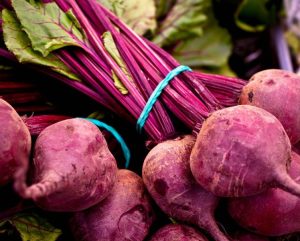
Beet, Red – Red beets are root vegetables known for their earthy flavor and vibrant red-purple color. They are rich in nutrients like folate, manganese, potassium, dietary fiber, and antioxidants such as betalains, which help reduce inflammation and support heart health. Both the roots and greens are edible, with the greens offering additional nutrients like vitamins A and C. Beets can be eaten raw in salads, roasted, boiled, or blended into smoothies and soups. Store beet greens separately from the root, wrapped in a damp cloth or in a plastic bag in the fridge. Use within a few days – they don’t keep long. Beetroots can be stored in a plastic bag in the fridge’s crisper drawer for up to two weeks. To freeze beets for longer storage, slice or chop them, spread on a cookie sheet to flash freeze, then transfer to freezer bags where they can be stored for up to a year.
 Baby Red Beet – These young, tender versions of mature red beets are harvested earlier for their milder, sweeter flavor and delicate texture. Like full-sized beets, they’re rich in folate, fiber, potassium, and antioxidants, but their gentle taste and thin skins make them especially suited for quick roasting, steaming, or even raw applications like grating into salads. The greens are also edible and nutrient-dense — great sautéed or added to soups. Store baby beets as you would store mature beets.
Baby Red Beet – These young, tender versions of mature red beets are harvested earlier for their milder, sweeter flavor and delicate texture. Like full-sized beets, they’re rich in folate, fiber, potassium, and antioxidants, but their gentle taste and thin skins make them especially suited for quick roasting, steaming, or even raw applications like grating into salads. The greens are also edible and nutrient-dense — great sautéed or added to soups. Store baby beets as you would store mature beets.
💡Tip: You don’t have to peel baby beets before eating — especially if they’re roasted or steamed. Their skins are thin and tender, so a good scrub is usually enough. After cooking, the skin often loosens and can be rubbed off easily if desired, but it’s totally fine (and nutritious) to leave it on. Raw baby beets can also be grated or thinly sliced with the skin intact.
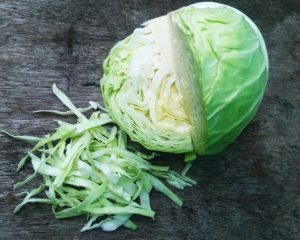 Cabbage, Green – Green cabbage is a nutrient-dense cruciferous vegetable in the Brassica family, known for its tightly packed, round, pale green leaves. It is rich in vitamins C and K, as well as fiber and antioxidants, which are beneficial for immune health, digestion, and bone strength. With a mild, slightly peppery taste, green cabbage can be enjoyed raw in salads and slaws, or cooked in stir-fries, soups, and stews. To store, keep green cabbage unwashed in a perforated plastic bag in the refrigerator’s crisper drawer, where it can stay fresh for up to two weeks.
Cabbage, Green – Green cabbage is a nutrient-dense cruciferous vegetable in the Brassica family, known for its tightly packed, round, pale green leaves. It is rich in vitamins C and K, as well as fiber and antioxidants, which are beneficial for immune health, digestion, and bone strength. With a mild, slightly peppery taste, green cabbage can be enjoyed raw in salads and slaws, or cooked in stir-fries, soups, and stews. To store, keep green cabbage unwashed in a perforated plastic bag in the refrigerator’s crisper drawer, where it can stay fresh for up to two weeks.
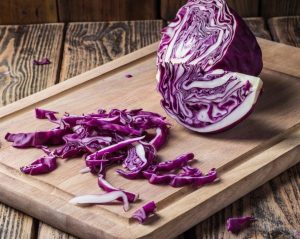 Cabbage, Red – Red cabbage is a vibrant vegetable with a slightly peppery and sweet flavor. It is rich in vitamins C and K, fiber, and antioxidants like anthocyanins, which support immune health, digestion, and reduce inflammation. Red cabbage can be eaten raw in salads and slaws, pickled, or cooked in stir-fries, soups, and stews. Store it in the refrigerator, unwashed, in a plastic bag, where it can stay fresh for up to two weeks.
Cabbage, Red – Red cabbage is a vibrant vegetable with a slightly peppery and sweet flavor. It is rich in vitamins C and K, fiber, and antioxidants like anthocyanins, which support immune health, digestion, and reduce inflammation. Red cabbage can be eaten raw in salads and slaws, pickled, or cooked in stir-fries, soups, and stews. Store it in the refrigerator, unwashed, in a plastic bag, where it can stay fresh for up to two weeks.
💡Tip: Try using red cabbage to make quick pickled cabbage. Thinly slice the cabbage, then toss it with vinegar, lime juice, a pinch of sugar, and spices like cumin or chili flakes. Let it sit for 30 minutes to develop flavor. The result is a tangy, crunchy topping that adds both texture and a pop of color to your meal. Perfect for tacos, burgers, or grain bowls!
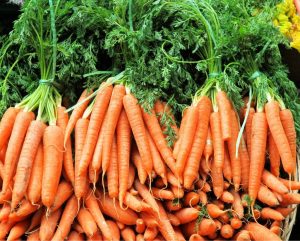 Carrot – Carrots are a versatile and popular root vegetable, known for their sweet, crunchy texture and vibrant orange color, though they can also be found in purple, yellow, and red varieties. They are rich in beta-carotene, which the body converts to vitamin A, essential for good vision and immune health. Carrots are a good source of dietary fiber, potassium, and antioxidants. Enjoy them raw, cooked, roasted, or juiced. They can be used in salads, soups, stews, and side dishes. For optimal storage, store carrots unwashed in the fridge, preferably in a plastic bag or container to maintain moisture, where they can last for several weeks. If the greens are attached, cut them off to prevent the carrots from becoming limp. Stored properly, they should last around 1-2 weeks.
Carrot – Carrots are a versatile and popular root vegetable, known for their sweet, crunchy texture and vibrant orange color, though they can also be found in purple, yellow, and red varieties. They are rich in beta-carotene, which the body converts to vitamin A, essential for good vision and immune health. Carrots are a good source of dietary fiber, potassium, and antioxidants. Enjoy them raw, cooked, roasted, or juiced. They can be used in salads, soups, stews, and side dishes. For optimal storage, store carrots unwashed in the fridge, preferably in a plastic bag or container to maintain moisture, where they can last for several weeks. If the greens are attached, cut them off to prevent the carrots from becoming limp. Stored properly, they should last around 1-2 weeks.

Carrot, Rainbow – In addition to the nutritional benefits above, rainbow carrots stand out from standard orange carrots with their vibrant colors—purple, yellow, red, and white—each offering unique nutritional benefits and distinct flavors. Purple carrots contain anthocyanins, powerful antioxidants linked to anti-inflammatory and heart-health benefits, with a slightly earthy, spicy taste. Yellow carrots are rich in lutein, which promotes eye health by protecting against macular degeneration and cataracts, and they have a mild, subtly sweet flavor. Red carrots contain lycopene, a potent antioxidant that supports heart health, reduces the risk of certain cancers, and helps protect skin from UV damage, with a richer, sweeter taste.
💡Tip: These colorful carrots are perfect for adding visual appeal to dishes and enhancing the taste profile, whether roasted to bring out their natural sweetness, or sliced raw for salads. Their distinct flavors can also add depth to juices and smoothies. The diverse hues, flavors, and nutrients of rainbow carrots make them perfect for garnishes or serving as part of a vegetable medley. Store rainbow carrots the same way you would store standard orange carrots.
 Celery – Celery is a crunchy, low-calorie vegetable known for its mild, slightly salty flavor. It is rich in vitamins K and C, folate, potassium, and fiber, supporting bone health, digestion, and hydration. Celery is often eaten raw as a snack, added to salads, or used as a base in soups, stews, and stir-fries. Store celery in the refrigerator, tightly wrapped in aluminum foil to retain its crispness, where it can stay fresh for up to two weeks. For longer storage, celery can be chopped and frozen.
Celery – Celery is a crunchy, low-calorie vegetable known for its mild, slightly salty flavor. It is rich in vitamins K and C, folate, potassium, and fiber, supporting bone health, digestion, and hydration. Celery is often eaten raw as a snack, added to salads, or used as a base in soups, stews, and stir-fries. Store celery in the refrigerator, tightly wrapped in aluminum foil to retain its crispness, where it can stay fresh for up to two weeks. For longer storage, celery can be chopped and frozen.
💡Tip: Don’t forget to use those celery greens! They’re a great addition to cooked beans, salads, eggs. Use leaves to make pesto or dry them and make your own parsley flakes, powder, or salt.
 Dandelion Greens, Red – A striking and slightly more tender variety of traditional dandelion greens, red dandelion greens are easily recognized by their deep green leaves and vivid reddish-purple stems and veins. Like their green-stemmed counterparts, they’re packed with vitamins A, C, and K, calcium, and antioxidants, but red dandelion greens tend to have a slightly milder bitterness and can be more visually appealing in dishes. Their bold color and flavor shine when lightly sautéed with garlic, added to soups or pasta, or eaten raw in salads (especially when balanced with citrus or fruit). Store unwashed greens in a loosely sealed bag with a damp paper towel in the fridge, using within 3–5 days for best quality.
Dandelion Greens, Red – A striking and slightly more tender variety of traditional dandelion greens, red dandelion greens are easily recognized by their deep green leaves and vivid reddish-purple stems and veins. Like their green-stemmed counterparts, they’re packed with vitamins A, C, and K, calcium, and antioxidants, but red dandelion greens tend to have a slightly milder bitterness and can be more visually appealing in dishes. Their bold color and flavor shine when lightly sautéed with garlic, added to soups or pasta, or eaten raw in salads (especially when balanced with citrus or fruit). Store unwashed greens in a loosely sealed bag with a damp paper towel in the fridge, using within 3–5 days for best quality.
Fun Fact: Despite the name, red dandelion greens aren’t true dandelions — they’re actually a type of chicory! But their similar leaf shape and bitter flavor earned them the name.
 Garlic Chives – Garlic chives are a member of the onion family, but with a distinct garlic flavor. Their long, flat leaves are a milder, more delicate alternative to garlic cloves and can be used both raw and cooked. Nutritionally, garlic chives are rich in vitamins A and C, calcium, and antioxidants. These versatile greens work wonderfully in salads, soups, stir-fries, or as a garnish for almost any savory dish. Store garlic chives in the fridge wrapped in a damp paper towel inside a plastic bag, and use them within 5–7 days.
Garlic Chives – Garlic chives are a member of the onion family, but with a distinct garlic flavor. Their long, flat leaves are a milder, more delicate alternative to garlic cloves and can be used both raw and cooked. Nutritionally, garlic chives are rich in vitamins A and C, calcium, and antioxidants. These versatile greens work wonderfully in salads, soups, stir-fries, or as a garnish for almost any savory dish. Store garlic chives in the fridge wrapped in a damp paper towel inside a plastic bag, and use them within 5–7 days.
Fun Fact: Garlic chives are also known as “Chinese chives” and are used widely in Asian cuisine. They can be used to make a flavorful chive oil, perfect for drizzling on dishes like dumplings or noodle soups.
 Green Garlic – Green garlic is simply young garlic harvested before the bulbs fully form. Its flavor is less intense than mature garlic, with a milder, fresher taste that is both garlicky and onion-like. Green garlic is a great source of vitamins A, C, B6, and minerals like manganese and calcium. It can be used in any recipe that calls for garlic, from sautés to soups, or used raw in dressings and pestos. Store green garlic in the fridge, ideally in a dry container with some airflow, and use it within a week for the freshest taste.
Green Garlic – Green garlic is simply young garlic harvested before the bulbs fully form. Its flavor is less intense than mature garlic, with a milder, fresher taste that is both garlicky and onion-like. Green garlic is a great source of vitamins A, C, B6, and minerals like manganese and calcium. It can be used in any recipe that calls for garlic, from sautés to soups, or used raw in dressings and pestos. Store green garlic in the fridge, ideally in a dry container with some airflow, and use it within a week for the freshest taste.
Fun Fact: Green garlic is a seasonal treat, available only in the spring. While it looks like a scallion or young leek, its flavor is distinctly garlic—making it a great ingredient for early spring recipes!
 Ginger – Ginger is a flavorful root widely used as a spice and natural remedy. It has a warm, slightly spicy taste and is rich in bioactive compounds like gingerol, which has anti-inflammatory and antioxidant properties. Ginger aids digestion, relieves nausea, and supports immune health. It is versatile in cooking and used in teas, curries, stir-fries, baked goods, and beverages. Store fresh ginger in a cool, dry place for short-term use or in the refrigerator in a paper towel or airtight bag for extended freshness. For long-term storage, freeze peeled or sliced ginger.
Ginger – Ginger is a flavorful root widely used as a spice and natural remedy. It has a warm, slightly spicy taste and is rich in bioactive compounds like gingerol, which has anti-inflammatory and antioxidant properties. Ginger aids digestion, relieves nausea, and supports immune health. It is versatile in cooking and used in teas, curries, stir-fries, baked goods, and beverages. Store fresh ginger in a cool, dry place for short-term use or in the refrigerator in a paper towel or airtight bag for extended freshness. For long-term storage, freeze peeled or sliced ginger.
💡Tip: Freeze your fresh ginger for longer storage: Peel and slice or grate the ginger. Freeze in an airtight container or ice cube tray. You can also freeze the whole unpeeled root in a freezer bag. Grate or slice directly from frozen as needed.
 Green Onions – Green onions, also known as scallions, have a mild, slightly sweet onion flavor and are packed with vitamins A and K. They are often used raw in salads, salsas, and garnishes but also add depth to stir-fries, soups, and omelets. Their green tops and white bulbs are both edible, making them a versatile ingredient. Store in the refrigerator, wrapped in a damp paper towel inside a bag, or stand them in a jar of water to keep them fresh longer.
Green Onions – Green onions, also known as scallions, have a mild, slightly sweet onion flavor and are packed with vitamins A and K. They are often used raw in salads, salsas, and garnishes but also add depth to stir-fries, soups, and omelets. Their green tops and white bulbs are both edible, making them a versatile ingredient. Store in the refrigerator, wrapped in a damp paper towel inside a bag, or stand them in a jar of water to keep them fresh longer.

Lettuce, Loose Leaf – Leaf lettuce, known for its loose, leafy structure and mild, slightly sweet flavor, comes in green and red varieties. It is a low-calorie vegetable packed with vitamins A, C, and K, as well as folate and fiber, making it a nutritious choice for salads and wraps. Its tender leaves are best used raw in salads, sandwiches, or as a garnish. Store leaf lettuce in the refrigerator, loosely wrapped in a damp paper towel inside a plastic bag or container, and use it within a week to maintain freshness and crispness.
💡Tip: Don’t miss this exclusive Weekly Salad Greens Subscription to get the freshest greens in the Lehigh Valley every week!
Mushroom Varieties
Store mushrooms in a paper bag or breathable container in the refrigerator, avoiding moisture buildup, and only wash them right before use to maintain freshness.
Mushrooms are super versatile in the kitchen. Here are10 Things You Should Do With Mushrooms.
This roundup of 20 Mushroom Recipes has you covered with meal ideas for breakfast, lunch, or dinner.
Mushroom, Portobello & Cremini – Portobello mushrooms are mature versions of cremini mushrooms, offering a meaty texture and rich, earthy flavor. Cremini, also known as “baby bellas,” are younger, smaller, and have a firmer texture with a milder taste. Both are low in calories, fat-free, cholesterol-free, and provide B vitamins, selenium, potassium, and antioxidants. Portobellos are ideal for grilling, roasting, or as a meat substitute in burgers, sandwiches, or stuffed recipes. Creminis are great for sautéing, adding to soups, stir-fries, pasta dishes, or as pizza and salad toppings.
💡Tip: The artisan mushroom sampler is a great way to try different varieties of mushrooms. While we can’t predict or guarantee what will be included, the sampler often includes varieties such as enoki, oyster, shiitake, or trumpet mushrooms!
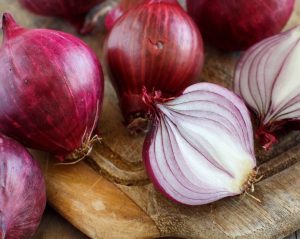 Onion, Red – Red onions are a vibrant, mildly sweet onion variety with a sharp bite, commonly used raw or cooked in various dishes. They are a good source of vitamin C, antioxidants, and fiber, contributing to overall health and supporting the immune system. Red onions add color and flavor to salads, salsas, sandwiches, pickles, and roasted vegetable dishes. Store whole red onions in a cool, dry, well-ventilated space away from sunlight; once cut, refrigerate in an airtight container and use within a few days to preserve freshness.
Onion, Red – Red onions are a vibrant, mildly sweet onion variety with a sharp bite, commonly used raw or cooked in various dishes. They are a good source of vitamin C, antioxidants, and fiber, contributing to overall health and supporting the immune system. Red onions add color and flavor to salads, salsas, sandwiches, pickles, and roasted vegetable dishes. Store whole red onions in a cool, dry, well-ventilated space away from sunlight; once cut, refrigerate in an airtight container and use within a few days to preserve freshness.
Fun Fact: Red onions get their color from anthocyanins, which can turn bluish-green when cooked with alkaline foods such as some beans and legumes. Adding a little acid (like vinegar or lemon juice) helps keep their color vibrant.
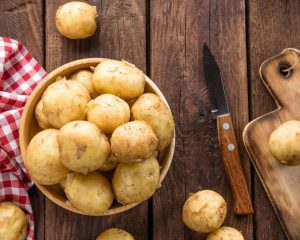 Potato, Yellow – Also known as Yukon Gold or gold potatoes, yellow potatoes have smooth, thin, yellowish skin and creamy, buttery-flavored flesh. They are slightly waxy, making them versatile in cooking. Yellow potatoes are a good source of vitamin C, potassium, and fiber and are low in calories and fat. Their creamy texture makes them ideal for mashing, roasting, grilling, and boiling. They are also excellent in gratins and salads because they hold shape during cooking. Store yellow potatoes in a cool, dark, and well-ventilated place for several weeks, avoiding refrigeration as it can alter their texture and flavor.
Potato, Yellow – Also known as Yukon Gold or gold potatoes, yellow potatoes have smooth, thin, yellowish skin and creamy, buttery-flavored flesh. They are slightly waxy, making them versatile in cooking. Yellow potatoes are a good source of vitamin C, potassium, and fiber and are low in calories and fat. Their creamy texture makes them ideal for mashing, roasting, grilling, and boiling. They are also excellent in gratins and salads because they hold shape during cooking. Store yellow potatoes in a cool, dark, and well-ventilated place for several weeks, avoiding refrigeration as it can alter their texture and flavor.
💡Tip: Looking for a surprising combo to elevate your potatoes? Try pairing roasted yellow potatoes with a drizzle of honey and a pinch of cinnamon for a sweet-savory side. Or, mix them into a salad with pickled beets for an earthy contrast that’s totally unexpected. For another twist, mash roasted yellow potatoes with beets for a creamy, earthy side dish – the sweetness of the beets complements the savory potatoes beautifully.
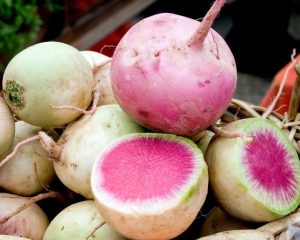 Radish, Watermelon – Watermelon radish is a striking root vegetable with a mild, slightly sweet flavor and a crisp texture. Its pale green skin hides a vibrant pink interior, resembling a watermelon. Rich in vitamin C, potassium, and antioxidants, it supports immune health and reduces inflammation. Watermelon radishes can be enjoyed raw in salads, sliced thinly for garnishes, pickled, or roasted for a milder flavor. Store unwashed watermelon radishes in a perforated plastic bag in the refrigerator, where they can stay fresh for up to two weeks. Wash and trim just before using.
Radish, Watermelon – Watermelon radish is a striking root vegetable with a mild, slightly sweet flavor and a crisp texture. Its pale green skin hides a vibrant pink interior, resembling a watermelon. Rich in vitamin C, potassium, and antioxidants, it supports immune health and reduces inflammation. Watermelon radishes can be enjoyed raw in salads, sliced thinly for garnishes, pickled, or roasted for a milder flavor. Store unwashed watermelon radishes in a perforated plastic bag in the refrigerator, where they can stay fresh for up to two weeks. Wash and trim just before using.
💡Tip: Watermelon radishes make beautiful and delicious chips! Try this easy recipe: Toss thin slices with a little oil and salt, spread on a parchment-lined sheet, and roast at 400°F for 15-20 minutes, flipping halfway through. They’re finished when the edges begin to curl and the radishes turn lightly brown and crispy. Keep an eye on them – they go from perfect to too dark very quickly. Pair finished chips with herbed goat cheese or yogurt, guacamole, or hummus.
 Rhubarb – Rhubarb is a unique perennial vegetable known for its vibrant red or green stalks. While technically a vegetable, it’s most often treated as a fruit in cooking, thanks to its tart, tangy flavor. Rich in vitamin K, fiber, and antioxidants, rhubarb is often used in desserts like pies, crumbles, and jams, though it can also complement savory dishes when paired with meat like pork. The leaves of rhubarb contain toxins and should never be eaten, but the stalks are perfectly safe to enjoy. Store rhubarb in the fridge, wrapped in a damp cloth or in a sealed plastic bag, and use within a week for the best flavor.
Rhubarb – Rhubarb is a unique perennial vegetable known for its vibrant red or green stalks. While technically a vegetable, it’s most often treated as a fruit in cooking, thanks to its tart, tangy flavor. Rich in vitamin K, fiber, and antioxidants, rhubarb is often used in desserts like pies, crumbles, and jams, though it can also complement savory dishes when paired with meat like pork. The leaves of rhubarb contain toxins and should never be eaten, but the stalks are perfectly safe to enjoy. Store rhubarb in the fridge, wrapped in a damp cloth or in a sealed plastic bag, and use within a week for the best flavor.
💡Tip: To reduce rhubarb’s natural tartness, cook it with some sugar or honey, or combine it with sweeter fruits like strawberries in desserts for a balanced flavor.
Fun Fact: Rhubarb was originally used in ancient Chinese medicine for its health benefits, long before it became a culinary favorite!
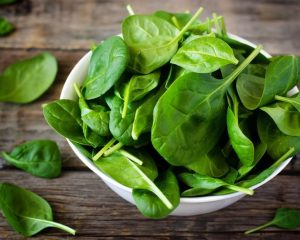 Spinach – Spinach is a nutrient-rich leafy green vegetable packed with vitamins A, C, K, folate, and minerals like iron and magnesium. Low in calories and high in antioxidants, it supports eye health, bone strength, and immune function. Spinach is versatile and can be enjoyed raw in salads, blended into smoothies, or cooked in soups, pasta, and omelets. To store, keep it dry in a perforated plastic bag in the fridge’s crisper drawer, and wash only before use. Properly stored, it stays fresh for 5-7 days.
Spinach – Spinach is a nutrient-rich leafy green vegetable packed with vitamins A, C, K, folate, and minerals like iron and magnesium. Low in calories and high in antioxidants, it supports eye health, bone strength, and immune function. Spinach is versatile and can be enjoyed raw in salads, blended into smoothies, or cooked in soups, pasta, and omelets. To store, keep it dry in a perforated plastic bag in the fridge’s crisper drawer, and wash only before use. Properly stored, it stays fresh for 5-7 days.
Fun Fact: During medieval times, spinach juice was used as ink for artwork due to its rich green pigment.
 Stinging Nettle – This wild, nutrient-rich leafy green is known for its fine, hair-like spines that sting when touched raw, though cooking, drying, or blending neutralizes the sting entirely. It has a mild, earthy flavor similar to spinach and has long been used in both culinary and herbal traditions. Nettles are packed with vitamins A, C, K, and B-complex, as well as iron, calcium, magnesium, potassium, and plant-based protein. They’re popular in soups, pestos, egg dishes, sautéed greens, and teas. Always blanch before eating to remove the sting. Store fresh nettles in the fridge wrapped in a damp paper towel inside a produce bag. Use within a few days, or blanch and either freeze or dry for long-term use.
Stinging Nettle – This wild, nutrient-rich leafy green is known for its fine, hair-like spines that sting when touched raw, though cooking, drying, or blending neutralizes the sting entirely. It has a mild, earthy flavor similar to spinach and has long been used in both culinary and herbal traditions. Nettles are packed with vitamins A, C, K, and B-complex, as well as iron, calcium, magnesium, potassium, and plant-based protein. They’re popular in soups, pestos, egg dishes, sautéed greens, and teas. Always blanch before eating to remove the sting. Store fresh nettles in the fridge wrapped in a damp paper towel inside a produce bag. Use within a few days, or blanch and either freeze or dry for long-term use.
💡Important Tip: Always handle raw nettles with gloves or tongs.
Fun Facts: Stinging nettles aren’t just good for you—they’re good for the planet, too. Nettles grow abundantly without fertilizer and can be harvested multiple times a season. They’re considered a low-impact wild green, especially when foraged responsibly. Plus, they’re a favorite host plant for butterflies like the Red Admiral and Small Tortoiseshell, making them a quiet hero in supporting local pollinators and biodiversity.
 Sweet Potato, Fingerling – Sweet potato fingerlings are small, slender sweet potatoes with thin, edible skin and a naturally sweet, creamy texture. They are rich in fiber, beta-carotene, and vitamin C, promoting digestive and immune health. Roast, sauté, or air-fry them whole for a crispy skin and tender interior, or slice them into fries or hash. Store in a cool, dry place away from light, but avoid refrigeration as it can affect their texture.
Sweet Potato, Fingerling – Sweet potato fingerlings are small, slender sweet potatoes with thin, edible skin and a naturally sweet, creamy texture. They are rich in fiber, beta-carotene, and vitamin C, promoting digestive and immune health. Roast, sauté, or air-fry them whole for a crispy skin and tender interior, or slice them into fries or hash. Store in a cool, dry place away from light, but avoid refrigeration as it can affect their texture.
💡Tip: Roast whole or halved with herbs and spices for a simple side or mash with a touch of butter and cinnamon for a comforting dish.
Don’t forget: Online shopping opens Friday at 1 PM! 🛒 Stock your kitchen with these clean, nourishing ingredients to fuel your family with nutrient-dense meals. Be sure to grab your favorite staples and try something new for vibrant health this winter.
Don’t wait to join…
Veggie E-Books
Download these collections of tips and recipes for each veggie. You’ll use these as a reference throughout the season.
Arugula E-Book
Asparagus E-Book
Beets E-Book
Cabbage E-Book
Carrots E-Book
Fresh Herbs E-Book
Lettuce E-Book
Mushrooms E-Book
Onions E-Book
Potatoes E-Book
Radish E-Book
Scallion/Green Onion E-Book
Spinach E-Book
~~~~~
Farm News and Events:
Garden-Inspired Art Workshop: Create Stunning Flower-Pounded Prints! 🌿🎨
Date: Saturday, May 3rd, 10 AM – 12 PM (THIS SATURDAY!)
Location: Willow Haven Farm General Store, 8150 Hamilton Blvd, Breinigsville, PA 18031
Cost: $40
Ages: 12+
🌸 What You’ll Create:
- Two 8×8” wooden plaques with beautiful, nature-inspired designs
- Four handmade note cards perfect for gifting or displaying
- A deeper appreciation for the colors and patterns of garden blooms
🌿 What to Expect:
- Step-by-step guidance on selecting, arranging, and transferring flowers
- A relaxed, welcoming atmosphere—no experience necessary!
- All supplies provided—just bring yourself and a creative spirit
- 🎨 Note: Paints used are permanent on clothing, so dress accordingly!
Stay for a fresh, organic lunch in our café after the workshop and enjoy the full farm-to-table experience! 🌱🍽
Spots are filling fast—half of the class is already full, so don’t wait!
💌 Register now by emailing WHFGeneralStore@gmail.com to secure your spot for this Saturday!
Visit our Facebook event page for more details!
~~~~~
Mother’s Day Greeting Card Workshop with Barbara Benson 💐💌
Date: Saturday, May 10th, 1:30 PM
Location: Willow Haven Farm General Store, 8150 Hamilton Blvd, Breinigsville, PA 18031
Cost: Free to attend (Registration required)
Join our greeting card crafter, Barbara Benson, and learn how to make beautiful, personalized cards just in time for Mother’s Day! This hands-on class will guide you through the process of creating heartfelt, handcrafted cards that will truly show Mom how much you care.
🌸 What You’ll Make:
- A unique, handcrafted card for Mother’s Day
- A fun, memorable experience creating something special with the kiddos
🎨 Who’s Welcome: All ages (perfect for kids and adults alike!)
💌 How to Register: Email WHFGeneralStore@gmail.com to secure your spot!
Visit our Facebook event page for more details!
We’ll keep farming for you!
Reuben and Tessa DeMaster
Willow Haven Farm


